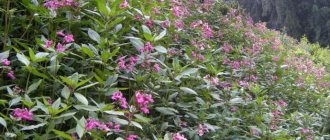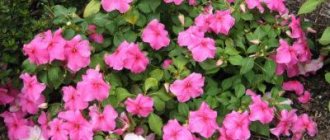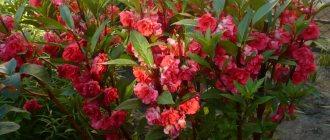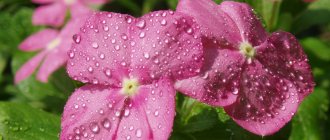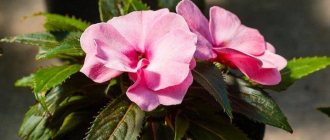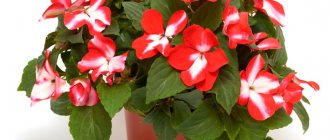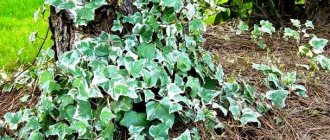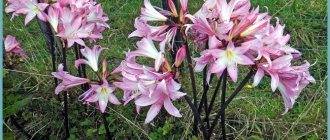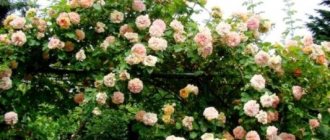Impatiens is a very popular flower due to its beauty and unpretentiousness.
Impatiens is one of the oldest inhabitants of gardens and apartments, which does not lose its popularity even today. It is enough to go to any forum of flower growers and gardeners, where you can always find many photos and discussions, the hero of which is Vanka wet. This is the second common name of the flower in our country, due to the fact that after watering small droplets form on the leaves. But the British call it “zealous Lisa” for its long flowering.
Description of Impatiens or Impatiens
The plant consists of one- and two-year-old flowers and shrubs, reaching from 20 to 1 m in height. Shiny fleshy leaves with sharp toothed edges, shaped like an oval. There are about 500 species in nature, and breeders have developed the most resistant varieties to our climatic conditions, resistant to pests and diseases.
Hybrids have both simple and velvety flowers of purple-pink colors. Spurs form in the opened inflorescences, touching which after ripening causes a sharp eruption of seeds.
Currently, more than a thousand hybrid species of Impatiens are known; they are grouped into two main categories.
- Common Impatiens walleriana is one of the most common plants used to decorate public parks and gardens around the world. This herbaceous perennial plant is considered an annual in frost-free climates. Standard Impatiens are available in a variety of colors, grow best in full or partial shade and can reach up to 60cm in height depending on the variety.
- New Guinea balsam (Impatiens hawker)—also popular because of its higher sunlight tolerance—is a hybrid variety that produces larger, brighter colors than standard Impatiens. New Guinea balsam is mildew resistant and can grow up to 1m tall, with foliage in a variety of colors including green, purple and bronze. It is generally more difficult to grow from seed.
Perennials
Varieties of perennial balsam are mainly used for growing indoors. They are room sized and, unlike annuals, have enlarged leaves. Feeding of such varieties can be done either with the same frequency as annuals, or once every two months. Like them, they do not like direct sunlight, but for them sunlight is more destructive.
IMPORTANT: This balsam should only be placed near northern and western windows.
Most varieties of perennial balsams are hybrid offshoots of Waller's balsam , and these include the following species:
- Waller's balsam;
- creeping;
- Niamean or parrot;
- New Guinean.
In fact, there are many other species, but most of them are extremely rare, such as Niamey balsam. However, some species do well both when grown as perennials and as annuals. For example, creeping balsam does not have a clearly defined stem, so it is often grown as an ampere plant, which is why it can be grown both in the garden for decoration and at home on the windowsill.
Rules for planting and caring for Ogonyok in open ground
Garden Balsam loves natural light, the lack of which affects its flowering and growth. You can get a long stem devoid of buds. Therefore, they mainly choose western and eastern directions on the site to create flower gardens with this plant. But in intense summer heat, you should consider the possibility of shading, otherwise the Impatiens will simply burn.
Growing garden balsam seedlings from seeds
It is recommended to sow garden balsam seeds in the ground in March, but it is possible in early April, it depends on the climatic conditions of the region. With earlier sowing, crops will need to be supplemented with light, which is not always possible.
In order for Ogonyok to develop comfortably, wide containers with drainage holes are selected for sowing. The optimal solution is cassettes, which are used for planting different crops. A layer of expanded clay must be placed on the bottom of the pot, after which soil is placed. The soil chosen is loose, based on peat, sand, perlite in equal proportions. A prerequisite is to treat the mixture with a fungicidal preparation to eliminate the possibility of fungi.
Seeds also require additional processing before sowing. They are dipped in potassium permanganate, kept there for 20 minutes, after which they are soaked in a preparation that stimulates crop growth. Then the seed is washed and dried on a napkin.
When the seeds are distributed in the container, they need to be sprinkled with soil or buried slightly, but not more than 5 mm. The optimal distance between seeds is up to 3 cm. To make planting convenient, you can use a moistened toothpick. After sowing, the soil must be sprayed with water from a spray bottle, and the container is covered with film or glass. The container with plantings can be placed on the windowsill, but provided that it is not exposed to direct ultraviolet rays.
You can observe the first shoots after one and a half to two weeks. Sometimes it happens earlier. It is important that the daylight hours are about 12 hours, and that the seedlings themselves receive good air ventilation.
Crops should be watered in a tray to avoid excess water. When up to 7 leaves are formed on the plants, they can be planted in separate pots. Before transferring balsam to the garden, be sure to harden it.
You might be interested
Decorative liana Ipomoea: cultivation and use in garden design
Red perennials: the best plants to grow in the garden
Perennial shade-loving flowers and plants for the garden: a selection of the best plants
Planting Balsam seedlings in open ground
Ogonyok is planted in a pre-prepared hole, fertilized with peat, humus and drained with sand. Transferring from the pot is done very carefully, as the plant can easily break. After filling with soil, the root system is watered and drainage is arranged. Impatiens love water, but its stagnation is just as dangerous for them as lack of watering. Irrigation every 2-3 days during periods when the sun does not dry out the surface of the earth very quickly will be sufficient.
Rooted bushes can be pinched to obtain a more bushy version of the plant. Nitrogen-potassium fertilizing of soil for balsam guarantees gorgeous flowering throughout the season. If a row of impatiens is to be planted, an interval of 30 cm is maintained so that the root system does not grow together.
Reproduction methods
Impatiens propagate in two ways:
- Using seeds . They are sown in January in a sand-peat mixture, after dipping them for 10 minutes in a solution of potassium permanganate and soaking them in water for a day. Seeds germinate in about 2 weeks.
- Using apical cuttings 6 cm long (vegetative propagation method). They are cut and placed in water or immediately planted in a sand-peat mixture. Cuttings germinate very quickly: after 2 months they can already bloom.
Impatiens seeds remain viable for five to six years.
Pots for balsam need to be selected not wide, but deep. In general, impatiens does not like spacious pots. According to many experts, the tighter it is, the better it blooms. The bottom of the plant containers is covered with expanded clay.
How to care for garden balsam in the garden
When choosing a place for planting and further care, you need to take into account which group of balsams your flower belongs to.
What kind of soil does a flower need?
Grow garden impatiens in fertile, well-drained soil. It needs a lot of water, so it is important that your soil provides adequate drainage. If you are planting in a container such as a window box or hanging basket, use well-drained soil.
Enrich the soil with nutrients. Before planting, fertilize the soil with aged compost. This organic food will provide your Impatiens with the extra nutrients they need to thrive.
Lighting
Choose a shady place for the plant, protected from the wind. Common Impatiens are one of the few flowering plants that grow best in shade, while New Guinea Impatiens typically do best in partial sun.
Watering Impatiens
Water the plants regularly to keep the soil moist. About 2 inches of water per week is the optimal amount of moisture, but be careful not to overwater. Applying a layer of organic mulch can help the soil retain moisture and prevent leaves from wilting in hot weather. If you have planted your seedlings in a pot, they will generally need more water than if they were planted in the ground.
Fertilizer
Fertilize garden balsam regularly throughout the growing season. Regular fertilizing promotes healthier flowering of Impatiens flowers. Use water-soluble fertilizer every two weeks as directed. If you used a slow-release fertilizer at planting time, you can apply the same fertilizer again in midsummer.
Collecting Ogonyok seeds
To collect your own Impatiens seeds, you don't have to do anything very complicated. It is enough to take a bag or box and bring it to the achene, and then touch it.
The second option is to collect seeds along with the boxes. This is done early in the morning, but this procedure requires more dexterity. The bolls should be gently squeezed with your fingers, the stalks should be torn off, and the achenes should be rubbed between your fingers. The contents must be dried on a plate, after which they are placed in paper bags. Proper storage guarantees excellent seed germination - up to 8 years.
Photo
Here you can find a photo of a perennial garden balsam, and below we will talk about the features of planting the plant and caring for it.
Problems in caring for the Ogonek flower in the garden
Caring for Balsam is not a very labor-intensive process. But it is necessary to replant perennial lights at least once a year and carefully check the foliage for diseases. From time to time, inspect the plant for spider mites, which are often found in these flowers. To combat the pest, use a solution based on laundry soap; if the folk remedy does not help, then you will have to resort to insecticides. Also, sometimes crops can be affected by aphids. To get rid of the insect, tobacco dust is best suited, which is sprinkled on the soil and the plant itself. When attacked by whiteflies, it is best to resort to sticky traps.
Pests and diseases
Tender impatiens in the garden are lurked by malicious pests:
- Aphid. Small insects that feed on cell sap. These insects can cause great harm when the colony grows. They secrete a sweet liquid, which becomes an excellent medium for the growth of sooty fungus. Traditional methods will help get rid of pests - spraying with a soap or ash solution, tincture of marigolds, tobacco, and dandelion.
- Spider mite. The tiny parasite bites into leaf blades, extracting cell sap. As a result, the growth becomes covered with dots, turns pale and crumbles. It is easy to detect a colony of insects by the presence of thin threads of cobwebs on the underside of the leaves. Acaricidal drugs will help in the fight.
- Thrips. When small streaked spots appear on the crown, leaves curl and wilt, we can talk about a thrips attack. These pests are very dangerous because they spread plant viruses. It is not so easy to remove them; at least 2-3 treatments with insecticides, for example, Actellik, Confidor, Intavir, will be required.
Rot caused by fungi is common among diseases. It is easier to prevent them by following a watering regime that prevents excessive moisture. If traces of fungi appear in the form of various spots with a small edge, remove the damaged parts and treat with Bordeaux mixture.
Remember! Prevention of fungal diseases is pre-sowing treatment, compliance with planting and watering rules.
With viral mosaic, the leaf blades turn yellow and become wavy. Bronzing slows growth and wrinkles the foliage, after which it crumbles. Ring mosaic is characterized by stains that cause dryness, cracking and fading. If any of the described signs of viral diseases appear, immediately remove and burn the infected specimens.
Garden Balsam in landscape design
Garden Light can be used in garden decoration for various functional and aesthetic purposes due to the presence of many varieties of this plant. They will decorate borders and paths, create a beautiful background or add a bright accent to the heart of the entire composition.
They are planted in pots in small garden areas for vertical gardening. The exterior of buildings is also decorated in this way. Container Balsams will become bright lights near recreation areas and in courtyard areas. Verbena, Fuchsia, Begonia will be excellent “neighbors”.
If you use group planting, you can get a whole field of incredibly luxurious flowers. The use of balsams of various shades will give the garden an enchanting sound. This plant allows you to realize the full creative potential of the owner of the site and is guaranteed to get a positive result from your work.
Popular types of Impatiens for the garden
This plant can be divided into two large groups: garden and indoor balsams. They have common features and growing requirements, but domestic species are less resistant to weather changes. Let us describe popular garden species.
Tom Thumb (Impatiens Tom Thumb)
Tom Thumb (Impatiens Tom Thumb)
A spreading balsam a quarter of a meter in height. Pleasant to the touch, lanceolate-serrate foliage frames velvety buds, which can be soft white, bloody, lilac, or pinkish in color.
Balsam Camellia (Impatiens Camellia)
It grows in the shape of a pyramid, formed from fleshy foliage and large 4 cm buds of milky, lilac shades or a compilation of them.
Waller's Impatiens (Impatiens walleriana)
The name unites several subspecies, differing in flower texture (simple or double), color scheme (all shades of red), petals (plain or with pale stripes).
Waller's Impatiens (Impatiens walleriana)
Their advantage is the shape of the bush - it is ideal for a gardener who is fond of topiary, as it often represents an almost perfect circle. Flowering occurs profusely during the warm period of the year.
Balsam Exotic (Impatiens Exotic)
A bush up to 15-20 cm with serrated-lanceolate leaves and burning buds of deep pink, soft lilac, lilac and all their various variations.
Garden balsam variety Carmelita
This is an annual crop that grows up to 0.7 meters. The flower is thermophilic, shade-tolerant, and moisture-loving. It is distinguished by large inflorescences of different colors. Flowering is observed from June to September.
New Guinea balsam (Impatiens hawker)
This group of hybrids is large in size, but there are small flowers. The height reaches up to 1 m cm. The leaves have a wide range of colors - from bronze to dark green, with a yellow center. The stem is usually reddish in color.
New Guinea balsam
This ornamental plant is presented in a variety of species, which will satisfy the aesthetic needs of the most demanding gardener. Lately, hanging balsam has become quite common. Among indoor balsams, we can distinguish varieties of terry balsam, popular among gardeners, such as Athena, Salsa Red White and others.
